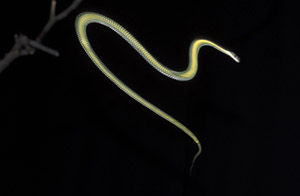 Citations
Citations
Researchers
locate leukemia gene defect
The discovery of a gene
defect that causes leukemia in children with Down syndrome may speed diagnosis
and provide a new target for therapy. John Crispino
of the Ben May Institute for Cancer Research and Michelle
Le Beau, professor of hematology/oncology, reported
their team's discovery and its implications in the August 12 advanced online Nature
Genetics. Children with Down syndrome are 10 to 20 times more likely than
other children to develop leukemia-usually the rare acute megakaryoblastic leukemia
(AMKL) form. When the researchers compared DNA from 75 leukemia patients and 21
healthy people, they found that all six patients with Down syndrome and AMKL had
an altered GATA1 gene. The other patients' genes were not mutated.
 |
A
paradise tree snake after take-off.
©
Jake Socha, National Geographic Society |
I'll
believe that when snakes have wings
They don't have wings, but they
do fly. To move between tree branches and the ground, flying snakes of Southeast
Asia coil the front of their bodies into a "J" shape, jump up and away,
then flatten out to provide lift and stability, Jake Socha,
a graduate student in organismal biology & anatomy, reported in the August
8 Nature. Then the snake shimmies in a side-to-side "S" shape,
flying like a sidewinder moves. "I can't think of anything else that moves
this way in the air," says Socha, who has videotaped more than 1,000 snake
flights over six years. In the 100 or so years since the first published reports
of flying snakes, Socha's is only the second detailed study.
The
next step in chemotherapy
Chicago researchers have combined cancer chemotherapy
with a type of gene therapy that stops tumors from growing new blood vessels and
thus limits the growth of the tumor. Tested in mice, the combination is far more
effective than standard chemotherapy and has no added side effects. Derived from
a similar approach combining gene therapy with radiation, the new method "not
only enables us to target the original tumor but also potentially to aim at the
small clusters of cancer cells that may have spread to distant sites," says
Ralph Weichselbaum, the Daniel K. Ludwig professor
and radiation oncology chair, who directed the study, which appeared in the August
Journal of Clinical Investigation.
Survival
doesn't guarantee...survival
Surviving five great mass extinctions doesn't
guarantee an organism evolutionary success, geophysical-sciences professor David
Jablonski wrote in the June 11 Proceedings of the National Academy of
Sciences. In a global analysis of marine fossils at the genus level, Jablonski
found 10 to 20 percent of lineages that survived the five largest mass extinctions
in Earth's history proceeded to die off in the next 5 million or 10 million years-a
significantly higher amount than die off during stable periods. This extinction
ripple divides the survivors into "winners and losers," Jablonski says.
Taking his cue from a 1995 movie, Jablonski dubbed the last representatives of
their clades-groups of organisms including an ancestor and all of its descendants-"dead
clades walking."
Danger
in diabetes drugs
The oral medications most widely used to lower blood-sugar
levels in patients with type 2 diabetes are likely to increase the risk of coronary-artery
spasms. A Chicago research team, led by assistant professor in cardiology
Elizabeth McNally, reported its findings in the July 15 Journal of Clinical
Investigation. The study focused on mice with a genetic defect that duplicates
the actions of sulfonylurea drugs. The drugs, the researchers found, constrict
arteries and therefore increase blood pressure and decrease blood flow to the
heart, causing chest pain and even sudden death.


![]() Contact
Contact
![]() About
the Magazine
About
the Magazine ![]() Alumni
Gateway
Alumni
Gateway ![]() Alumni
Directory
Alumni
Directory ![]() UChicago
UChicago![]() ©2002 The University
of Chicago® Magazine
©2002 The University
of Chicago® Magazine ![]() 5801 South Ellis Ave., Chicago, IL 60637
5801 South Ellis Ave., Chicago, IL 60637![]() fax: 773/702-0495
fax: 773/702-0495 ![]() uchicago-magazine@uchicago.edu
uchicago-magazine@uchicago.edu
